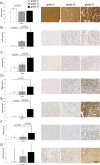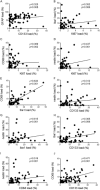Novel association between microglia and stem cells in human gliomas: A contributor to tumour proliferation?
- PMID: 27499894
- PMCID: PMC4858136
- DOI: 10.1002/cjp2.7
Novel association between microglia and stem cells in human gliomas: A contributor to tumour proliferation?
Abstract
Brain tumour stem cells and microglia both promote the growth of astrocytomas, the commonest form of primary brain tumour, with recent emerging evidence that these cell types may interact in glioma models. It is unclear whether microglia and stem cells are associated in human gliomas. To investigate this question, we used the technique of tissue microarrays to perform a correlative study of a large number of tumour samples. We quantified immunostaining of human astrocytic tumour tissue microarrays (86 patients; World Health Organisation grade II-IV) for microglia Ionized calcium binding adaptor molecule 1 (Iba1) and CD68, and stem cell nestin, SOX2 and CD133. Ki67 was used to assess proliferation and GFAP for astrocytic differentiation. Immunoreactivity for both microglial markers and stem cell markers nestin and SOX2 significantly increased with increasing tumour grade. GFAP was higher in low grade astrocytomas. There was a positive correlation between: (i) both microglial markers and nestin and CD133, (ii) nestin and tumour cell proliferation Ki67 and (iii) both microglial markers and Ki67. SOX2 was not associated with microglia or tumour proliferation. To test the clinical relevance, we investigated the putative association of these markers with clinical outcomes. High expression for nestin and Iba1 correlated with significantly shorter survival times, and high expression for nestin, Iba1, CD68 and Ki67 was associated with faster tumour progression on univariate analysis. On multivariate analysis, nestin, CD133 and Ki67 remained significant predictors of poorer survival, after adjustment for other markers. These results confirm previous in vitro findings, demonstrating their functional relevance as a therapeutic target in humans. This is the first report of a novel correlation between microglia and stem cells that may drive human astrocytic tumour development.
Keywords: brain tumour; glioma; microglia; stem cells.
Figures



References
-
- Stupp R, Mason WP, van den Bent MJ, et al Radiotherapy plus concomitant and adjuvant temozolomide for glioblastoma. N Engl J Med 2005; 352: 987–996. - PubMed
-
- Stopschinski BE, Beier CP, Beier D. Glioblastoma cancer stem cells–from concept to clinical application. Cancer Lett 2013; 338: 32–40. - PubMed
-
- Yin AH, Miraglia S, Zanjani ED, et al AC133, a novel marker for human hematopoietic stem and progenitor cells. Blood 1997; 90: 5002–5012. - PubMed
-
- Singh SK, Clarke ID, Terasaki M, et al Identification of a cancer stem cell in human brain tumors. Cancer Res 2003; 63: 5821–5828. - PubMed
Grants and funding
LinkOut - more resources
Full Text Sources
Other Literature Sources
Research Materials
Miscellaneous

